If you’re into wall diving, you’ll be in wall-to-wall paradise at Wakatobi.
No matter how many times you’ve experienced it, that initial moment when you reach the edge of a sheer underwater wall will always be a thrill. One second, you are finning through a shallow coral reef, the next you are suspended over the edge of the abyss. This topographic contrast is particularly keen at Wakatobi Dive Resort, where many of the dive sites include precipitous walls that begin at very shallow depths – some less than 10 feet deep and plunge to a vertical trajectory to depths well beyond the accepted limits of sport diving. Join us for this virtual wall flying dive adventure that goes vertical.
Over the Edge
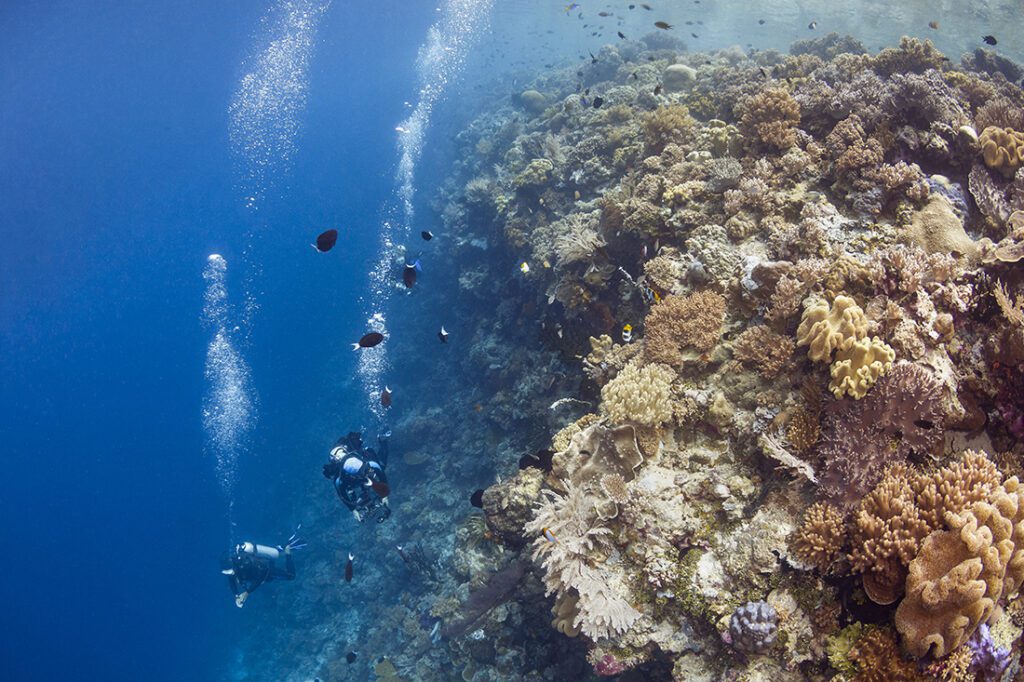
The dive boat’s captain gently maneuvers in close to the edge of reef. Morning sunlight penetrates the water’s calm surface, providing a dramatic glimpse of what lies below. The contrast is stunning between the ocean’s deep hypnotic blue and the sudden rise of the reef’s crest looking shallow enough to stand in. Looking over the side, you can follow a large portion of the wall’s sheer face a good way down through crystal clear water.
A final gear check and a giant stride later you’re confronted by a shallow realm above and the deep below as you begin descending with a subtle venting of your BCD. Along the way a large, colorful jade green anemone with its host of clownfish close the edge of the wall catches your eye, but they can wait. Right now, it’s time to visit the basement. Flanked by your buddy and your dive guide, the three of you descend in formation like skydivers free falling in slow motion. Traveling at a leisurely pace your dive computer’s depth readings start ticking into the triple digits while at the same time, the landscape has undergone some dramatic changes.
Down here, sheltered from surface wave action and storm surge, things grow bigger. The face of the wall is dotted by groves of outsized soft coral trees and sea fans broader than two times your outstretched arms. Sponges down in this more shadowy world begin to take on more outlandish proportions, like barrel sponges that have grown much larger than an actual barrel. You wish you had set up to shoot wide-angle this morning, but then again, there’s more walls than you can count, and of course, there will be some cryptic critters taking shelter amongst the wall’s crevices.
Photo Diver with red sea fans and wire coral

Take a quick virtual ride on a few of Wakatobi’s walls > here on YOUTUBE
There are also several types of fish you hadn’t noticed on some of the shallower dives, like anthias and basslets with striped markings or blotchy color patterns in vivid hues that look almost electrified. A burst of movement and color catches your eye. It’s a smallish orange and pink fish that holds near the wall, then periodically dashes into open water, flaring its fins and seeming to turn an even brighter shade of orange, pink and purple. Recalling a pre-dive briefing, you recognize this as a male flasher wrasse, intent on attracting the attention of a potential mate.
A Wakatobi dive guide attracts your attention with a “come over” motion. She’s floating close to a large gorgonian, pointing to what looks like, well, more branches of the gorgonian. You look. Then look closer. Nothing. Then finally, you see it: a tiny seahorse, small enough to lay across your fingernail, with a coloring and texture that perfectly mimics its gorgonian host. You can be excused for not seeing this tiny creature. The pygmy seahorse’s camouflage is so perfect that scientists didn’t discover most of the species until after the year 2000.
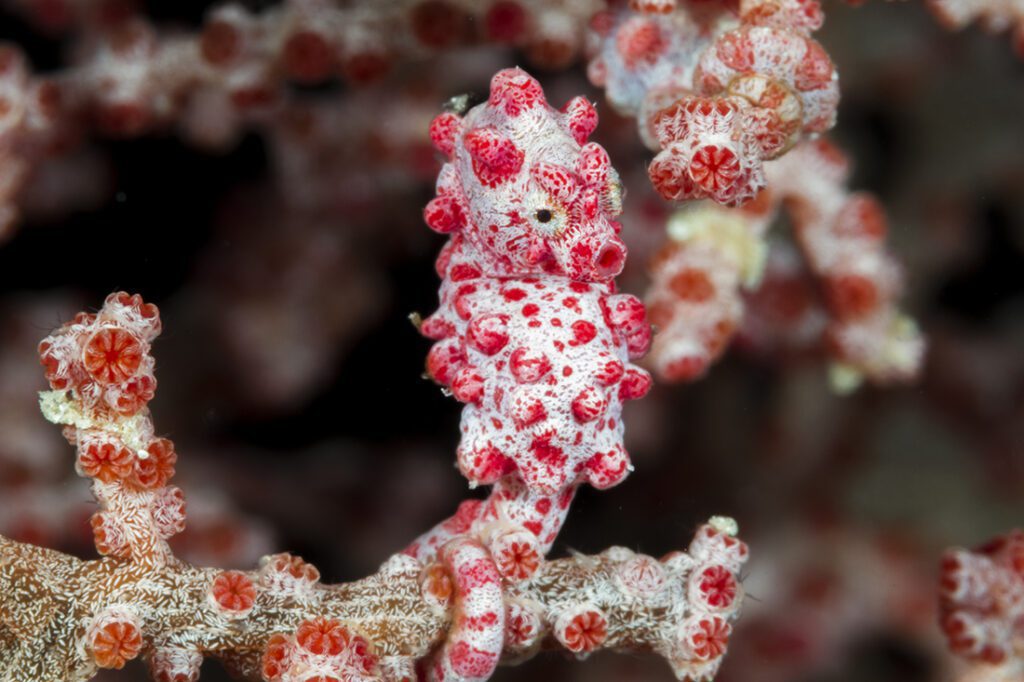 Photo by Walt Stearns
" class="wp-image-47642" title="Wakatobi’s Wall to Wall Paradise 3" srcset="https://divernet.com/wp-content/uploads/2023/05/MG_7124-300x200.jpg 300w, https://divernet.com/wp-content/uploads/2023/05/MG_7124-768x512.jpg 768w, https://divernet.com/wp-content/uploads/2023/05/MG_7124-1024x682.jpg 1024w, https://divernet.com/wp-content/uploads/2023/05/MG_7124.jpg 1100w" sizes="(max-width: 1024px) 100vw, 1024px">
Photo by Walt Stearns
" class="wp-image-47642" title="Wakatobi’s Wall to Wall Paradise 3" srcset="https://divernet.com/wp-content/uploads/2023/05/MG_7124-300x200.jpg 300w, https://divernet.com/wp-content/uploads/2023/05/MG_7124-768x512.jpg 768w, https://divernet.com/wp-content/uploads/2023/05/MG_7124-1024x682.jpg 1024w, https://divernet.com/wp-content/uploads/2023/05/MG_7124.jpg 1100w" sizes="(max-width: 1024px) 100vw, 1024px">Your photographic endeavors to capture the little guy start to get the best of you as you try to stay steady with seemingly nothing below you. But, before any frustrations can set in, your guide steps in to act as a human tripod. With one hand held steadfast to a piece of lifeless rock, the other under your arm or by the top of your tank, the task suddenly turns easy. Click of the shutter, and you have him. While you consider yourself lucky to have seen one, remember to thank your dive guide for both her sharp eyes and her steady assistance.
The Middle Ground
Time seems to stand still as you hold motionless alongside the towering face of the wall. But the nitrogen clock is running, and there’s much more to see. Your guide leads you on a slow upward traverse toward more intermediate depths, where the face of the wall is pockmarked by an extensive network of shadow-filled undercuts and caverns. At an evening presentation in the Longhouse a couple nights ago, the dive center manager explained that sections of the wall within this depth range were shaped by wave action thousands of years ago, when sea levels were lower.
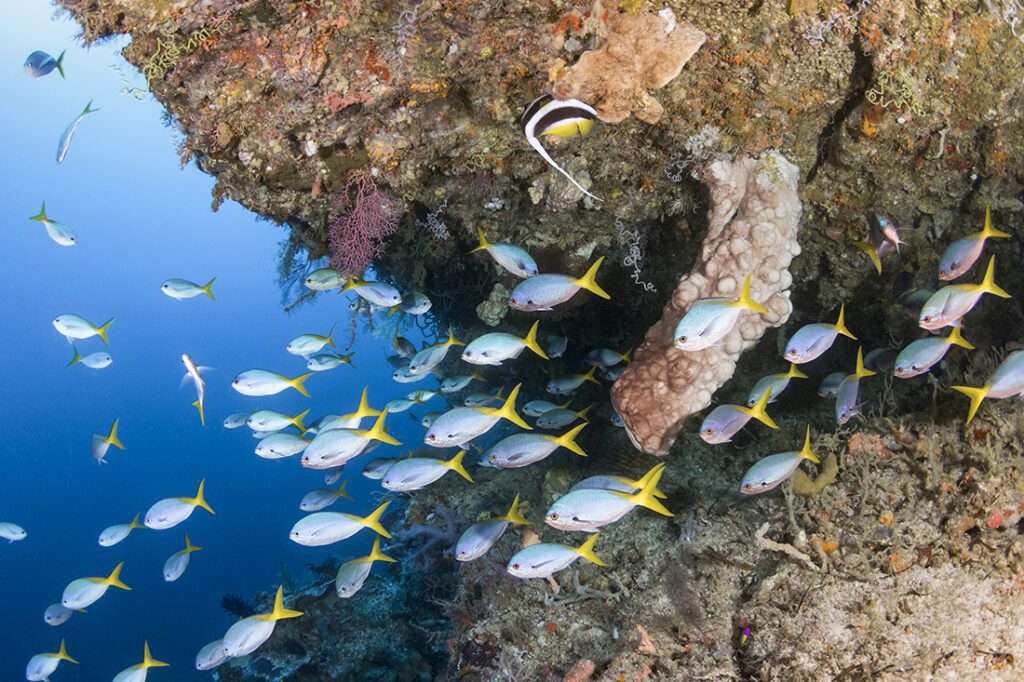
These ancient erosions now provide shelter for a variety of reclusive creatures, which are revealed by a careful approach and the judicious use of a small dive light. The telltale antennae as lobsters project from a crevice, another recess reveals a green turtle.
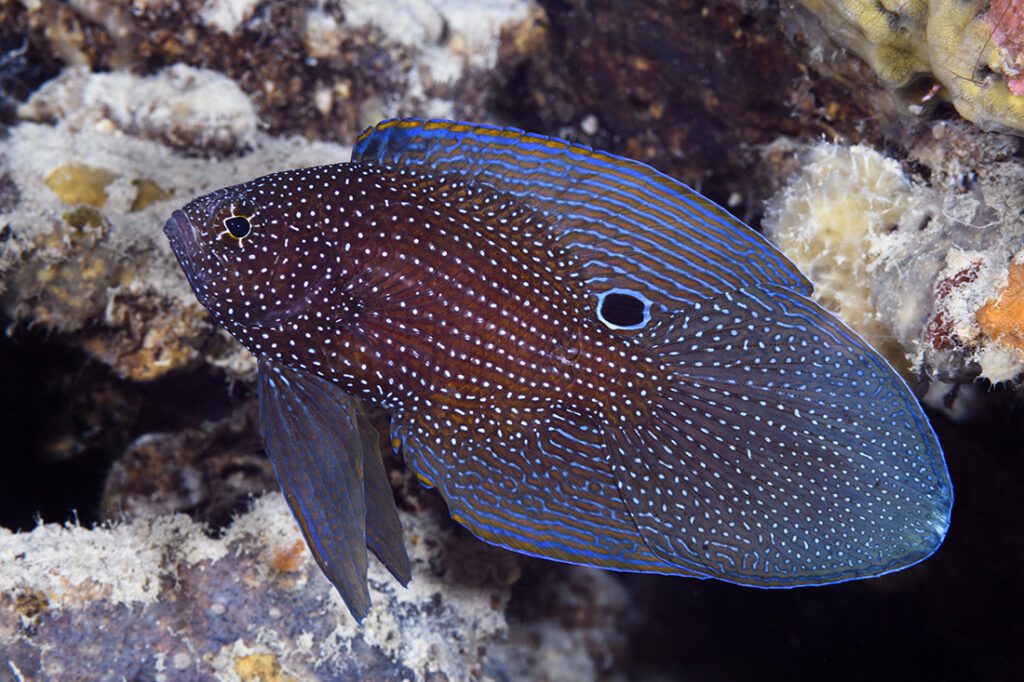
Glowing eyes stare back from a particularly deep crack, but you are unable to determine the identity of the creature. You do recognize the resident of another small cave, as this fish was also mentioned in the pre-dive briefing. Covered with vivid white spots set against a black body, this could only be the comet fish. Sure enough, it sports the distinctive eye spot near the base of it’s dorsal fin, which is there to fool would be predators into confusing head from tail. When the light’s beam strikes its flank, the comet fish spreads its fins, creating the illusion that it is much larger than actual size.
Topping if off
Progressing shallower to a depth most would stay at for a safety stop the dive is still far from over. A quick glance at your computer’s display shows your remaining no-stop time hasn’t even begun to reach single digits. Your pressure gage shows you still have a comfortable reserve to keep going and make the most out of Wakatobi’s trademark 70-minute profiles.

So, you use the last ten to 15 minutes exploring the reef’s coral covered shallow plateau. Back up top, the reef takes on a different look in the strong sunlight. The large red and orange gorgonians and sea fans are replaced by patches of leather coral and intricate formations of plate and tabletop coral. With the tide at near dead low, the corals rise almost to the surface, and their reflections are mirrored in the calm shallows of the water, creating a surreal double exposure of the reef.
After admiring the big picture, your attention returns to the details as you begin a hunt through the peaks and valleys of the coral crest. A school of black triggerfish, commonly referred to as black durgons, pass by, their pectoral and dorsal fins undulating with a flapping motion more akin to flight than swimming.
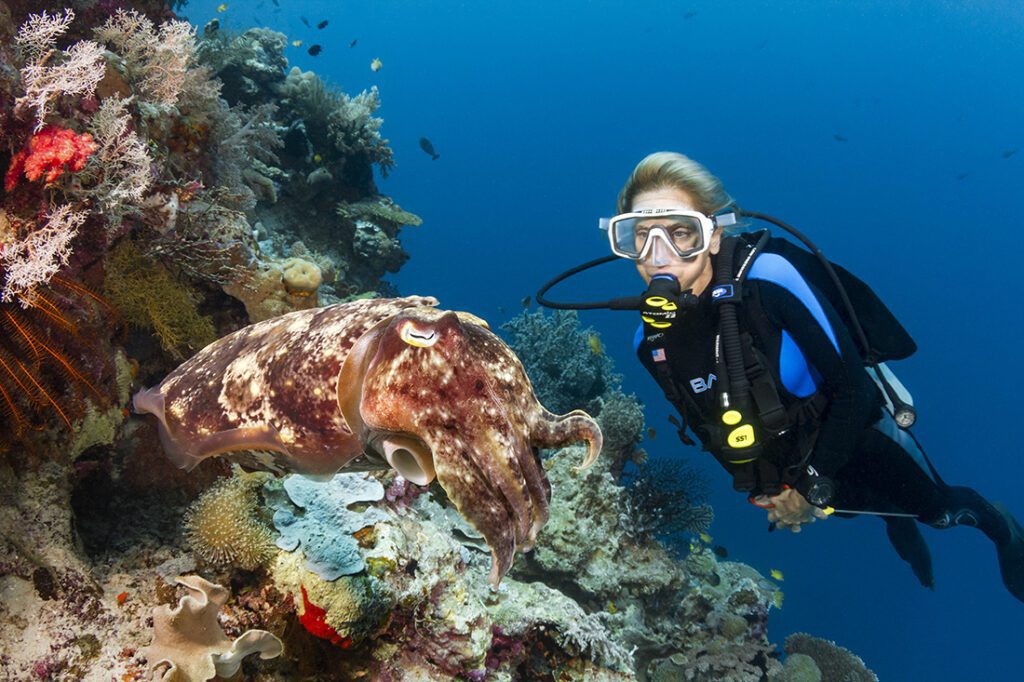
Next comes a cuttlefish or two), either on a solo hunt or scouting for the pack. This is prime territory for nudibranch enthusiasts, and it doesn’t take long to spot several of these brightly colored sea slugs making their slow journey through the undulations of the reef. More elusive are the pipefish, which are likely hiding somewhere in plain sight, silently biding their time in anticipation of a tasty morsel coming within range.
Looking over your guide motions the two of you to move up and out away from the reef so that the boat can pick you up. Your computer says 74 minutes have elapsed during the dive. Back on board, as you stare over the side in search of the cuttlefish that bid you goodbye, your guide flashes a big bright smile and asks, “ready for another dive?” You then realize there will be plenty more opportunities to discover these stealthy hunters and the many other amazing creatures that call the walls of Wakatobi home.
Ready for some wall diving? Contact the Wakatobi team at office@wakatobi.com or inquire >here.
Visit wakatobi.com for descriptions of more than 40 dive sites to explore – here

